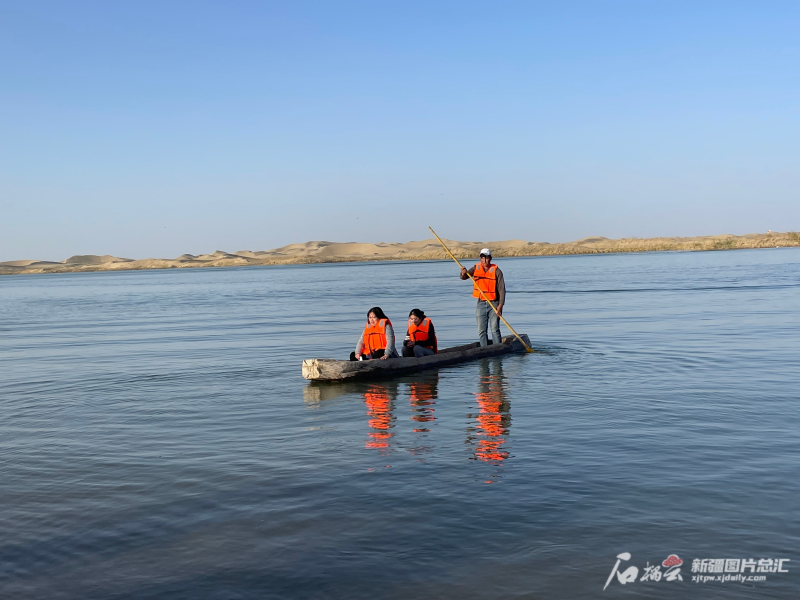Shiliuyun-Xinjiang Daily (Reporter Li Li) news: In autumn, the desert poplar trees along the Tarim River are putting on their golden dresses. Tourists view the scenery of desert poplar along the Tarim River, enjoy desert projects and experience the ethnic culture of Lop Nur people. The national 4A-level tourist attraction of Lop Nur People Village in Yuli County is crowded with visitors. "Since October, the daily passenger flow here has been around 10,000 people." Tian Chunxiang, deputy director of the management committee of the Lop Nur People Village scenic area, said.

Photo shows a tourist experience making wooden pots at the Lop Nur People Village scenic area in Yuli County, northwest China's Xinjiang Uygur Autonomous Region. (Photo by Zohra Osman)
Go sandboarding, camel riding and cross-country in the desert; canoeing in the sparkling lake, enjoying the autumn wind and having close contact with the desert poplar trees; walking into "hunting family", "fishing family" and "Lop Nur people family" to experience the daily life of the Lop Nur people; drinking a cup of Apocynum venetum tea in the teahouse; tasting the grilled fish, grilled meat, grilled watermelon and other special food; watching the lion dance, cooking dance and other special dances... The rich and diverse tourism projects in the Lop Nur People Village haunted tourists, especially the "Palazi" textile, Kapen (canoe made of whole poplar wood) fishing, making wooden pots and other ethnic culture experience projects.
"When weaving, you should pay attention to the position of the threads and the color of the fabric." On October 17, 2023, 68-year-old Qolpanhan Ibrayim explained to the tourists the details of the traditional textile technique at the "Palazi" folklore experience area.
"Palazi" is a traditional textile technique. This kind of fabric is made of wool, and the pattern is in various colors or black and white wide stripes, which can be used as carpets, bed blankets and decorations, and also as blankets for horses, camels and other riding tools. "I have heard from the elderly that people used to spin the yarn and looms to weave the cloth by spinning wheels, and I had never thought that I would experience the ancient textile techniques in the Lop Nur People Village scenic area." said Zhou Xiaohui happily, a tourist from east China's Shandong Province.

Photo shows a tourist experience traditional textile technique "Palazi" at the Lop Nur People Village scenic area in Yuli County, northwest China's Xinjiang Uygur Autonomous Region. (Photo by Zohra Osman)
Carefully step on the narrow canoe with a safe jacket on, follow the fisherman Amdon Barat, hold the harpoon, keep your eyes on the water, and hunt for fish. Canoe fishing is also a popular activity that many tourists are keen to experience. Living by the water, Lop Nur people make their livings by fishing. 68-year-old Amdon Barat started fishing since he was 9 years old, "There are different kinds of fishes in the lake such as wild grass carp, carp, and snakeheaded fish, and you must have patience when fishing, and pay attention to the balance of the boat while hunting for them."
In the Lop Nur People Village scenic area, there are several white-haired elderly people. They are spirited and have kind smiles on their wrinkled faces. They sometimes use poplar wood to make wooden pots, tea bowls or wooden spoons, sometimes play Dutar and sing songs such as "Red Roses" and others, sometimes chat with tourists and take pictures with them.
"I like to eat mutton and drink Apocynum venetum tea. I enjoy working, playing Dutar and singing songs. Living in such a beautiful environment, we are happy every day," Asked about the "secret" of longevity, 107-year-old Sulaiman Tohti responded with a smile.

Photo shows tourists experience canoe fish hunting at the Lop Nur People Village scenic area in Yuli County, northwest China's Xinjiang Uygur Autonomous Region. (Photo by Tian Chunxiang)
With traditional carpenter's tools such as adzes and choppers, tourists can cut down pieces of wood and dig out a groove in the wood. After experiencing the wood pot making, many tourists would like to take a photo with the old. "I especially like their kind and benevolent smile and their optimistic and open-minded attitude to life," said Tourist Guo Hongsen.
After experiencing the Lop Nur people's folklore activities, tourists can also go to the culture exhibition hall to learn more about the migration of the Lop Nur people, their integration with neighboring social groups, and the analysis of their longevity through physical objects and pictures. In the exhibition hall, there are also "Tarim River Management Hall" and as such. And there are sand plates to reproduce the 11 Han Dynasty beacon towers along the Kongque River that were listed as national key protected cultural relic units in these halls.

Photo shows tourists chat and take photos with locals at the Lop Nur People Village scenic area in Yuli County, northwest China's Xinjiang Uygur Autonomous Region. (Photo by Zohra Osman)
The total area of the Lop Nur People Village scenic area is 134 square kilometers, and in here the world's largest primitive poplar forest reserve, China's largest desert, the Taklimakan Desert, and the longest inland river, the Tarim River, meet each other. "We will continue to rationally utilize the desert, rivers, lakes, forests and other natural landscapes in the scenic area, further excavate and display the unique ethnic culture of Lop Nur people, continuously improve our service, enrich the cultural elements in the tourism industry, and strive to provide tourists with diverse tourism experiences," Tian Chunxiang said.
(A written permission shall be obtained for reprinting, excerpting, copying and mirroring of the contents published on this website. Unauthorized aforementioned act shall be deemed an infringement, of which the actor shall be held accountable under the law.)









